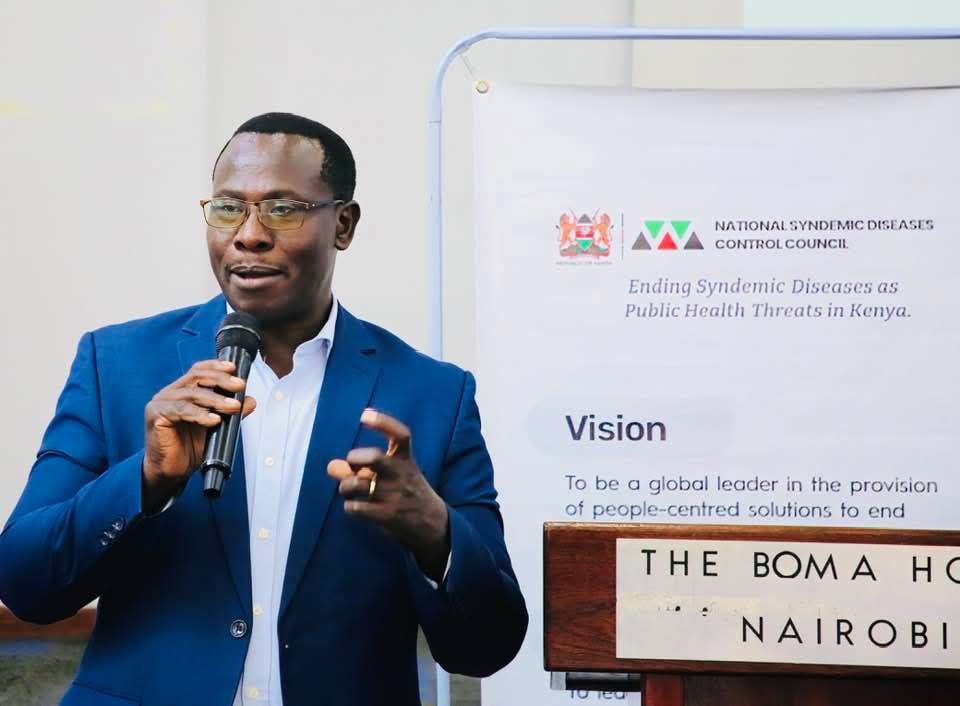PWDs urge grassroots awareness on New Disability Rights law
Stakeholders emphasized need for accessible education campaigns in Braille, large prin
“That data can’t give us enough resources for funding because it’s not disintegrated."
In Summary

Audio By Vocalize
 NSDCC Deputy Director, Health Metrics and Informatics Joshua Gitonga speaking during a people with disabilities' consultative forum in a Nairobi hotel on May 23, 2025./GEORGE OWITI
NSDCC Deputy Director, Health Metrics and Informatics Joshua Gitonga speaking during a people with disabilities' consultative forum in a Nairobi hotel on May 23, 2025./GEORGE OWITIKenya does not have up-to-date or detailed data on persons living with disabilities, a senior Ministry of Health official has said.
Petronila Bwaso, a programme officer with the Reproductive Maternal, Newborn, Child and Adolescent Health (RMNCAH) division, said the country still relies on outdated figures from the 2019 census, which estimated the number of people with disabilities at 2.2 million.
“That data can’t give us enough resources for funding because it’s not disintegrated into various age groups,” Bwaso told reporters on Friday during a meeting in Nairobi.
The meeting, hosted by the National Syndemic Diseases Control Council (NSDCC), brought together 50 representatives from the disability community.
It aimed to gather their input for the Kenya Syndemic Diseases Strategic Framework (KASF III) 2025–2030, which will guide the country’s response to HIV, TB, malaria, hepatitis, and other emerging health threats.
Newer estimates from the 2022 Kenya Demographic and Health Survey suggest that 15 percent of Kenyans aged five and above—about 7.5 million people—struggle with at least one functional difficulty, such as seeing, hearing, moving, or communicating. Around 5 percent, or 2.5 million people, face severe difficulties in these areas.
Common disabilities include mobility and vision challenges, each affecting about 2 percent of the population, while hearing, cognition, communication, and self-care affect 1–1.5 percent.
Access to healthcare remains a major hurdle.
According to the Kenya National Bureau of Statistics’ 2022 Support Needs Assessment Report, only 5 percent of persons with disabilities have health insurance, compared to 20–25 percent of the general population.
Barriers are widespread. Forty percent face physical challenges such as lack of ramps or accessible toilets.
Sixty percent report financial constraints, including transport and medical costs. One in four encounters discrimination or negative attitudes from healthcare providers.
Caregivers are also under strain. Seventy percent report physical exhaustion, 60 percent suffer emotional stress, and half have had to reduce or quit work to care for a person with disabilities.
Bwaso pointed to low registration and assessment rates in rural areas due to stigma and fear of social judgment.
“Most parents, especially in rural areas, fear bringing children with disabilities for assessment because of how the community will view them,” she said.
“We are calling for advocacy and community sensitization to help people with disabilities get the support they need.”
She also appealed for more funding and staffing.
“We need resources, including human resources and healthcare providers, to effectively support persons with disabilities,” she said.
“We’ve made our recommendations to the NSDCC and hope they will help address gaps in healthcare, assistive technology, and empowerment.”
Bwaso noted that many communities still see persons with disabilities as different and undeserving of equal treatment.
“Everyone should be told these are just like any other people. They shouldn’t be discriminated against. Discrimination and stigmatization is what has brought problems to us,” she said.
NSDCC Deputy Director for Health Metrics and Informatics, Joshua Gitonga, assured participants that their views would shape the upcoming strategy.
“We have not only listened but captured what you want to be included within the framework,” Gitonga said. “We will consolidate this input as we finalize the strategy.”
He also encouraged stakeholders to contribute further through the council’s online engagement platform
Stakeholders emphasized need for accessible education campaigns in Braille, large prin